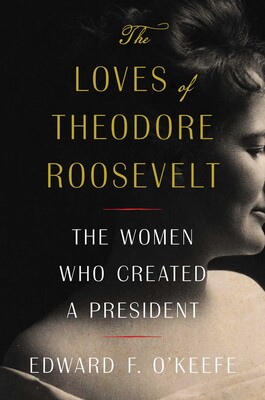The Loves of Theodore Roosevelt: The Women Who Created a President
- By Edward F. O’Keefe
- Simon & Schuster
- 464 pp.
- Reviewed by Kitty Kelley
- May 20, 2024
The swaggering leader owed much to the ladies in his life.

The huge granite sculpture startles tourists. Looming like a ferocious behemoth — intimidating, almost frightening — the 17-foot giant dominates the National Park Service space on the western bank of the Potomac River. If not for the “Welcome to Theodore Roosevelt Island” sign, one might assume the black stone colossus — his right hand raised as if to acknowledge the homage of marauding troops — towering above the cement-slab plaza was some sort of warring commissar. Yet spiraling out from the fearsome statue are 88 forested acres of majestic trees and woodland paths, designed by Frederick Law Olmsted Jr., paying tribute to the conservationist and naturalist who was the 26th president of the United States.
“T.R.,” or “Colonel Roosevelt,” as he preferred, could not abide being called “Teddy.” He believed that “physical bravery was the highest virtue and war the ultimate test of bravery,” according to one of his biographers, and all historians emphasize Roosevelt’s “warrior persona” and his “speak softly and carry a big stick” ideology. As president, he destroyed the portrait of himself by Théobald Chartran because he felt it made him look weak, like a “meek kitten.”
Declaring himself “as fit as a bull moose,” T.R. gloried in fighting wars and shooting and killing wildlife. He donated several specimens bagged on hunting trips, including a snowy white owl, to the American Museum of Natural History, which his father helped establish in 1869. In fact, it’s hard to think of a more testosterone-charged president than Theodore Roosevelt, the “Rough Rider” who championed the “bully pulpit,” launched construction of the Panama Canal, and brokered the end of the Russo-Japanese War, for which he won the 1906 Nobel Peace Prize, the first American to be so honored.
There are more than three-dozen biographies in print about Theodore Roosevelt (1858-1919), including his own memoir — one of the 47 books he wrote, including The Rough Riders, The Strenuous Life, African Game Trails, and Theodore Roosevelt’s Letter to His Children. Now comes another biography, The Loves of Theodore Roosevelt: The Women Who Created a President by Edward F. O’Keefe, CEO of the Theodore Roosevelt Presidential Library Foundation, the group spearheading the building of T.R.’s library, currently under construction in the Badlands of North Dakota.
O’Keefe’s first book, The Loves of Theodore Roosevelt presents an astonishing thesis about the man whose rugged visage is carved on Mount Rushmore and who may be regarded as the exemplar of the XY chromosome. This biography proffers that “the most masculine president in the American memory was, in fact, the product of largely unsung and certainly extraordinary women.”
The author argues that five women provided the ballast of Roosevelt’s life and were the source of his greatest accomplishments: his mother, Mittie; his sisters Bamie and Conie; and his two wives, Alice, who died after giving birth to their first child, and Edith, his second wife, with whom he had five more children. These women were “the team who would guide his future for the next several decades and craft his legacy.” Indeed, O’Keefe writes, the two greatest mistakes T.R. made were when he acted on his own without the counsel of his female consortium.
“The biggest blunder of his political life was a pledge he would not seek what he called a ‘third’ term” as president. As vice president to William McKinley, T.R. assumed the presidency in 1901 when McKinley was assassinated and, in 1904, won election on his own. Then, without consulting his closest confidantes — his wife and his sisters — the newly elected president announced that he would not seek re-election at the end of his first term, a decision he sorely regretted.
Roosevelt’s second blunder, again made without consulting his wife and sisters, was to announce William Howard Taft as his successor. Later, T.R. became so distressed by his lack of judgment that he founded the Progressive Party, popularly known as the Bull Moose Party, and ran, unsuccessfully, on a third-party ticket against Taft.
In researching Roosevelt’s life at Sagamore Hill National Historic Site in Oyster Bay, New York, O’Keefe discovered something that had eluded previous biographers: a small, blue velvet box, circa 1880, with a silk-covered divider that contained a secret keepsake — a photograph of Alice Hathaway Lee, T.R.’s first wife, and 14 inches of her wavy, dark, golden blond hair. On top of it was a note in Roosevelt’s own hand, reading: “The hair of my sweet wife, Alice, cut after death.”
Roosevelt has been described as an opportunist, exhibitionist, and imperialist. But O’Keefe presents a perceptive and persuasive argument that adds a sensitive dimension to the masculine persona of Theodore Roosevelt as a man indebted to the women in his life, proving, as 19th-century poet William Ross Wallace wrote, “The hand that rocks the cradle is the hand that rules the world.”
Kitty Kelley is the author of seven number-one New York Times bestseller biographies, including Nancy Reagan, Jackie Oh!, and The Family: The Real Story Behind the Bush Dynasty. She is on the board of the Independent and is the 2023 recipient of the Biographers International Organization’s BIO Award, which is given annually to a writer who has made major contributions to the advancement of the art and craft of biography.
